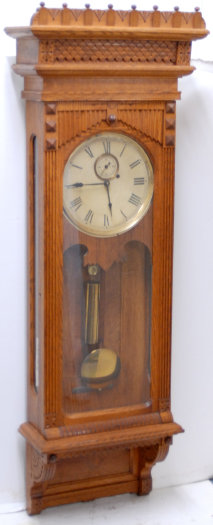
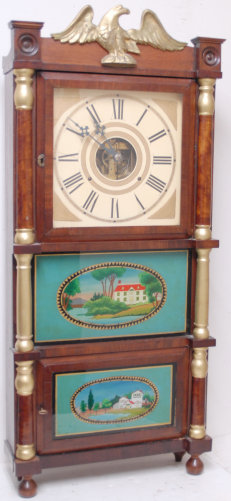
63. $2000
Seth Thomas Clock Co. “Regulator No. 9”, ca 1899. One of the
most popular case styles, at least for the four feet and under clocks. I have had a case like this since I first started collecting
in the early 1970’s. It is hanging in my den to this day. This 48” high case may be cleaner and nicer than mine but I do not wish
to swap. The books say it was made in walnut and cherry, sorry but most seem to be made of oak. This case was never very dark like
most old clocks that lived where coal was burned or tobacco was used. The case has been lightly polished but there are still sections
that have smoke accumulation. My collection of wood samples tells me this case was made with red oak, not white oak like most oak
cases. It certainly has a different look, straight line grain, not curly cue like white oak. Everything appears to be original, the
movement, the signed dial, three hands, brass bob, wood stick, brass pulley, brass weight, and brass beat scale. There is some touch
up on the dial. The back of the case has a factory stamp indicating the clock was made in 1899. It is running and only needs a place
to call home. If I only had a bigger house it would stay here. Ly-Seth Thomas, page 287. Has booked over $4500 for several years.
The last sale I can find was 2015 for over $3600. $2000-$3000.
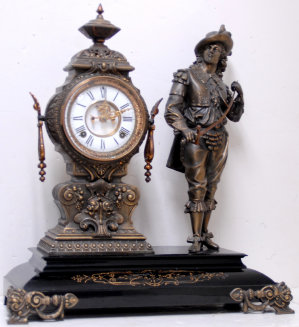
64. $400
Ansonia Clock Co. statue clock, “Don Juan”, ca 1894. This metal
figure clock was the only statue clock in this huge collection of early American clocks. Like No. 62 it seems he wanted just one of
certain type clocks. Many collectors seem to have that pattern of collecting. These old Ansonia statues did not retain their original
finish very well but some enterprising person had a new finish put on the statue. It really looks very nice. The case is 22 inches
high and 20 inches wide, complete and original as best we can tell. The black enameled iron base is clean and shining, retains good
gold in the etched designs, and has very few imperfections. The two piece porcelain dial is perfect however it does not have the Ansonia
insignia we normally see on their dials. So, is it a new dial? I don’t know. It has the original hands, open escapement, and beveled
glass in the sash. The case is metal except for the two brass side ornaments. The movement runs 8 day, is signed and running with
a correct pendulum, and strikes a standing gong on hours and half hours. Ly-Ansonia #466. $500-$750.
62. $350
“Birge, Mallory & Co. / Bristol, Conn.”, triple decker clock,
ca 1837-1843. The 8 day, two weight movement in this case is called a “strap frame”. The 39” high case is mahogany veneered. It has
been cleaned and polished and restoration on parts of the case such as renewed gold paint, veneer repairs where needed. Both doors,
top and bottom, are beveled, or angled; both have brass escutcheons, key locks, and a key. I believe the top glass to be original,
the middle more than likely, and the bottom I lean to a repaint or rebacked glass. The eagle top, capitals and bases on the half columns
top and bottom, and full turned middle columns, are all gold. The backboard is one piece of wood, and is original. The practically
complete paper label is dark but very good considering its age. The brass movement is signed, “BM&Co”, and it is complete,
and we in running condition. The two old iron weights and brass pendulum where hanging when the clock was brought to us. Good looking
wood dial has a good amount of gold on the four corners and the rings around the numerals. This collector restored this clock
to look like an original would have looked. Check out, “The Contributions of Joseph Ives to Connecticut Clock Technology, 1810-1862”,
by Kenneth D. Roberts, page 263. $500-$750.

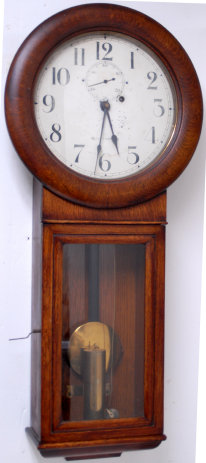
65. $400
Seth Thomas Clock Co. “Regulator No. 2”, ca 1890. Dark oak case
is 36 inches tall, very clean, highly polished, but is dark and ready to hang and enjoy. Thankfully it has not been cleaned of its
nice original finish. It has darkened over the 125 years since it was made but personally I like my oak clocks to be dark like walnut,
mahogany, etc. All wood case parts and internal parts appear to be original to each other. The painted metal dial is only slightly
soiled/aged, the slightest hint that the paint may be fragile, but that is normal for ST dials for they usually have lost a lot of
paint by this time. It is signed in two places, and has three correct hands. Signed 8 day movements is running, pendulum, pendulum
stick, brass weight, and beat scale, are all correct. No label or evidence there ever was one. America’s most collected clock. There
must be one in every home. If I had unlimited money and a huge warehouse I would buy everyone that came up for sale. Ly-Seth
Thomas, page 277. $500-$750.
61. $1250
Wm. L. Gilbert Clock Co. “Regulator
No. 10, Hanging”, ca 1910. We seldom see this model, and have only seen a couple sell in 40 years. There was one sold in an east coast
auction 15 years ago for over $5000, not nearly as nice as this near perfect clock. We have sold many Regulator No. 11 models, none
as nice as this clock. Some may complain that the 53” oak case is too nice but we see no indications it has ever been overly cleaned
or refinished. Perhaps polished or rubbed, but when you see no black in the multitude of grooves and carvings, you have to feel that
it has been protected thru its existence. It came to us with the superb collection of clocks, and the collector said it was the one
clock in his house that everyone tried to buy. Label on the back is mostly there. Accessories are brass and nickel; bob, weight, pulley,
beat scale, and dial rings. Two good glasses, one side glass has a crack, one held with the original putty, other two with new putty,
colored over. Good wood stick, burl insert in the back board, repainted dial, three correct hands, and the original 8 day time only
movement. If I were a Gilbert collector, this clock would not leave the house. Ly-Gilbert, page 135. $1500-$2000.


66. $450
Welch, Spring & Co. shelf calendar clock, “Arditi”, ca 1885.
One of the first calendar clocks this company made using the Gale patented calendar movement. Inside is a nice Gale label with operating
instructions. That is the pendulum hanging on the calendar movement in the picture. I forgot to remove it, sorry. The Welch Spring
8 day upper movement is signed by Welch, is running nicely and striking hours on a coil gong. There are no extra holes around the
movements or dial pans. Walnut case is 27” high, there has been no attempt to clean it and it is very dark and crusty, but looks good.
There is no case damage or repairs evident. The case design is very nice but void of any applied or carved pieces, just some good
jigsaw work and grooved designs over the top and side ornaments. The glass is original, so are both dials and hands. Everything else
is old and original. Ly-Welch, page 62. $500-$750.

67. $800
Seth Thomas Clock Co. “Regulator No.
1”, ca 1874. A very nice polished mahogany veneer case stands 34” high, and is like all the examples pictured in the catalogs
except most had a seconds dial. It is interesting that when they styles were changing from No. 1 to No. 2 they were almost identical.
Some No. 2’s had the label on the sliding partition in the beginning. All the cases with bases like this one, were 34 inches. Gold
gilt and black painted tablet is extra nice. If there is a serious nick, chip, or repair anywhere on the veneered case, I cannot see
it. The veneer is polished, smooth, and as nice as you will see on a clock 140 plus years old. The old dial pan has new paint, and
it appears they did not completely clean the pan of original paint. Good black label and white beat scale on the sliding partitions
over the weight chute. Pendulum bob, stick, hands, and gold paint around the lower glass, are all original. There are no key locks
on either door which leads me to believe the clock is a very late No. 1or an early No. 2. The clock is in operating condition and
will make a fine addition to any collection. Ly-Seth Thomas, pages 269-277. $1000-$1500.
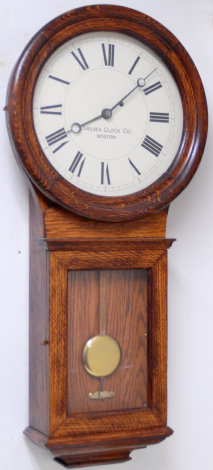
68. $500
Chelsea Clock Co. “No. 1 Pendulum”, office regulator in quarter
sawn oak, ca 1898. We have a good looking 34” high oak case that looks to be all original and is complete. Correct door latches and
glasses are original. The 8 day movement is original to the case, signed, and is running. The serial number on the movement is 11026.
Dates on the complete label on the back of the door are 1907 and 1908. Probably some repair person did something to the clock. The
brass pendulum bob and wood stick are correct, and the iron weight is correct. The dial was professionally repainted. The pendulum
tie down and baffle board over the weight are like new. The door latches do not work to my satisfaction but I am not a repairperson
so did not tinker with them. I get the impression that this clock was in an industrial setting, more dirty than a home would be. I
am going by the case back which is very smoky. It can sure be improved but maybe not to the $3000 value that it was just a few years
ago. Ly-American, Volume 1, page 78. $600-$900.


69. $1000
Waterbury Clock Company, “Regulator No. 67”, ca 1906. Dark oak
case is 50” tall, retaining the original finish, dark with smoke accumulation, but is clean. There are pressed designs on the top
rail, ripple molding below that, and several layers of other molding. The large door has ripple molding all around. There are two
door hooks and a large glass. We cannot say for sure the glass is original. The base has applied wood ornaments. The signed dial is
holding its original paint with light touchup around the three screw holes. The brass bob, wood stick, signed porcelain beat scale,
and brass pulleys, are all original. It has a complete label on the inside bottom of the case. The 8 day time only movement is running.
The iron weights are coated with varnish making it impossible to tell if they have imitation graining underneath the varnish. The
only demerit is scuff marks on the backboard where the pendulum banged around during hauling. Ly-Waterbury #573. $1250-$1500.
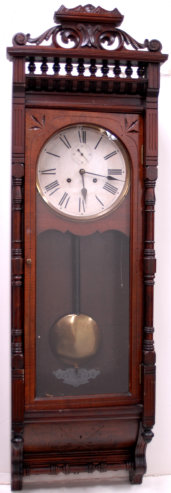
70. $750
Ansonia Clock Co. “Santa Fe”, a double weight time only eight
day movement in a large 52 inch walnut case, ca 1904. It has carvings, turnings, etchings from top to bottom, full turned columns
on the sides and everything with a dark stain. It is probably a little darker than when new but it is clean and polished and very
attractive in the dark case. The large 8 day weight driven movement is running. The beat scale is signed by Ansonia, weights, pendulum
and wood stick are original. The pendulum ball is signed, “F. J. Hulkenberg” and I would assume is the name of some former owner for
the name Hulkenberg does not show up in any clock publications that I can find. The nice painted metal dial has the Ansonia insignia
in the center and has their name and address on the bottom. Ly-Ansonia, pages 174-175. $800-$1200.